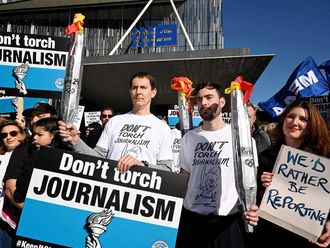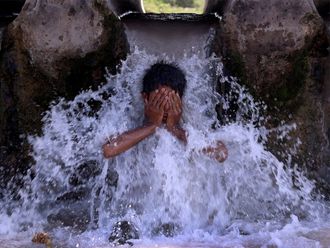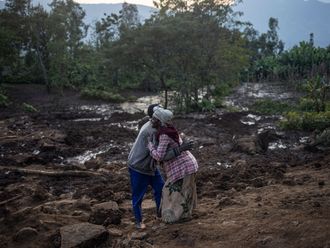Hugo Chavez’s populist brand of socialism divided Latin America while he was alive. But the continent united in mourning him, with many leaders praising his dedication to helping the poor. The question now is which leader will take up his mantle.
Argentina
President Cristina Fernandez de Kirchner
Cristina Fernandez swept to victory in the first round of Argentina’s presidential election in October 2007 — a victory that many attributed to the popularity of her husband, the then President Nestor Kirchner.
She fought the election campaign largely on Kirchner’s record of reducing poverty and unemployment in the wake of the 2001-2002 economic crisis — one of the worst the country had ever experienced.
But she faced a difficult start to her first term. Soon after being elected, her popularity dropped to 20 per cent as a result of disputes with farmers and media groups.
It also was widely believed that before his death in 2010, her husband, who was expected to stand again for the presidency, still ran the country behind the scenes.
However, bouyed by a booming economy, Fernandez was re-elected to a second term with a landslide 54 per cent of the vote in October 2011.
The couple were dubbed “the Clintons of the South”, and Fernandez encouraged the comparison by alluding to the similarities between herself and Hillary Clinton during her election campaign.
Bolivia
President Evo Morales
Socialist leader Evo Morales, a figurehead for Bolivia’s coca farmers, was elected in 2005, in a major historical shift for his country. Describing himself as the candidate “of the most disdained and discriminated against”, he was the first member of the indigenous majority to be elected president of Bolivia.
He was re-elected with a convincing majority over his conservative opponents in December 2009; his party also gained two-thirds majorities in both houses of parliament.
Morales made poverty reduction, the redistribution of wealth, land reform favouring poorer peasants and public control over Bolivia’s oil and gas resources his main priorities. He has nationalised much of the energy sector.
The president draws his support mainly from the poor indigenous majority, concentrated in the western highlands. Middle class voters and the eastern provinces, where most of the resource wealth lies, worry that his policies are too radical.
His promise to relax restrictions on growing coca irritated the US, which has bankrolled the fight against drugs in the country. In 2008, he ordered US drug enforcement officials to leave Bolivia.
He has also alarmed the US by forging strong links with Chavez.
Brazil
President Dilma Rousseff
Dilma Rousseff is the first woman to be elected as Brazil’s president.
She was chief of staff to her predecessor, president Luiz Inacio Lula da Silva, and also his favoured successor.
In the October 2010 elections to succeed President Lula, she narrowly failed to win an outright majority in the first round.
The result meant Rousseff faced the second-placed candidate, Sao Paolo mayor Jose Serra of the main opposition Social Democracy party, in a run-off vote on 31 October.
Rousseff, 62, was little known to her compatriots until Lula selected her as his favoured successor after a number of high-profile candidates were forced out by corruption scandals during his time in office.
She joined the government in 2003 as energy minister. In 2005, Lula made her his chief of staff, a post she held until March 2010, when she launched her campaign for the presidency as the Workers Party candidate.
She is known to favour a strong state role in strategic areas, including banking, the oil industry and energy.
In 2009, she was treated for and recovered from lymphatic cancer.
Cuba
President Raul Castro
Raul Castro, the world’s longest-serving defence minister, took over as president in February 2008, succeeding his ailing brother Fidel, who had been in power for five decades.
Raul Castro became acting president 18 months earlier when his brother was incapacitated by ill health, and was formally named as president by the National Assembly days after Fidel announced his retirement.
After being re-elected by the National Assembly in February 2013, Raul announced his intention to stand down at the end of his second term in 2018. He had earlier called for a two-term limit and age caps for political offices, including the presidency.
Raul, 76 at the time of this appointment, has been his brother’s trusted right-hand man and was once known as an iron-fisted ideologue who executed Fidel Castro’s orders - and enemies - ruthlessly.
Under his leadership, Cuba’s Revolutionary Armed Forces became one of the most formidable fighting forces in the Third World with combat experience in Africa, where they defeated South Africa’s army in Angola in 1987.
Raul Castro has also eased some restrictions on personal freedoms by lifting bans on mobile phones and home computers, and abolished the need of citizens to buy expensive exit visas when travelling abroad as tourists.
Ecuador
President Rafael Correa
Rafael Correa won the presidential elections in November 2006 promising a social revolution to benefit the poor and was re-elected in 2009 and again in February 2013.
When he originally took up his post in January 2007 he joined Latin America’s club of left-leaning leaders, including Venezuelan President Hugo Chavez and Bolivia’s Evo Morales, who have been highly critical of the US and led a South American nationalisation drive.
Following the 2013 poll he promised to press ahead with laws to control the media and redistribute land to the poor, apparently deepening his socialist revolution after a resounding re-election victory.
When he was first elected Correa, an outsider with no political party backing, moved quickly to win voters’ approval for a special assembly to rewrite the constitution in a referendum.
He said the new basic law would hand more power to the poor and reduce the role of the traditional parties, whom he blames for the country’s problems. Critics said it was solely aimed at increasing his powers.
On coming to power, Correa froze talks on a free trade pact with the US, saying it would hurt Ecuador’s farmers, and refused to extend the US military’s use of an air base on the Pacific coast for drug surveillance flights.
Nicaragua
President Daniel Ortega
Left-wing Sandinista leader Daniel Ortega made his political comeback in the November 2006 elections, having led Nicaragua through revolution and a civil war before being voted out in 1990.
Ortega was re-elected to another five-year term with a landslide victory in 2011, winning 63 per cent of the vote. Independent election observers, as well as opposition figures and US diplomats, voiced concern about the fairness of the poll.
His first period in office, in 1985-90, was marked by a programme of wealth distribution and a pro-Cuban orientation in foreign policy, which triggered a crippling trade embargo from the US administration of Ronald Reagan, which suspected Nicaragua of fomenting revolution elsewhere in Central America. The US also armed and funded attacks by Contra rebels.
A peace deal with the Contras led to the 1990 presidential election, which he lost to a former Sandinista ally turned liberal opposition leader, Violeta Chamorro, in the midst of public exhaustion and economic collapse.
By the time he came to stand for re-election in 2006, Ortega had toned down his former Marxist rhetoric in an effort to calm fears in a Nicaragua that, although seeing steady market-based economic growth, was still plagued by poverty and corruption.
Ortega has maintained close ties with fellow leftwing populist leaders in the region, in particular Chavez, and relations with the right-leaning pro-US Colombian leadership have been strained at times.
—Compiled from agencies










_resources1_16a30b3523c_small.jpg)

